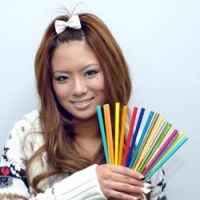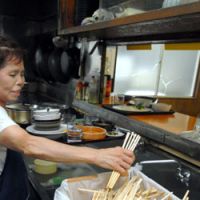I f I were writing about one of my favorite Tokyo eateries for the JT's Food Page, this story would mostly focus on its delicious fare. However, as this is the Nature Page, my verbal meanderings here are not about the nosh at cheap and cheerful Shokudo Shogetsu in Tamachi, but about the tools used to convey it to the mouths of diners.
In other words: chopsticks.
Every day, all over Japan, millions of people split open a pair of waribashi (disposable chopsticks) that come with their packed lunches bought at convenience stores or are provided by the establishment where they have decided to dine.
The Japanese government's Forestry Agency estimates that a whopping 25 billion pairs of waribashi are used in Japan every year — which translates to about 200 pairs per man, woman and child inhabiting the archipelego.
That's equivalent to the amount of timber required to build 17,000 houses of 120 sq. meters in size.
Or, if you take one typical waribashi to be 20-cm long, then 50 billion of them (those 25 billion pairs) put end to end would extend for a distance of 10 million km — enough to circle the Earth's 40,075-km Equator 250 times!
And all that's just one year's total of usually trashed, one-use-only chopsticks in Japan.
Recently, awareness of the environmental cost of waribashi has given rise to a movement that is steadily growing in popularity.
"My-hashi," as this movement is known in "Japlish," involves using your very own hashi (chopsticks) to eat with — instead of those provided as part of the service and then thrown away after you leave. Naturally, as long as they are properly washed, my-hashi are as reusable as a knife and fork.
As this eco-friendly trend gathers pace, one of Japan's best-known my-hashi users is 23-year-old Shiho Fujita. This charismatic young lady took Japan by storm when, at age 19, she set up her own company, SGR Inc., which markets cosmetics, perfume, shoes and clothing to young women.
But back then Fujita wasn't much of an environmental activist.
"I started to become more eco (environmentally conscious) when I noticed the garbage that was left on the streets in the Shibuya area of Tokyo that I love," Fujita said.
That's when she and a friend decided to pick up the garbage in the various parks around trendy Shibuya — places such as Sakuragaoka, Miyashita and Midake — on Monday mornings before beginning work in their nearby office.
"It felt good to see the parks looking cleaner, and besides, it was a lot of fun," she said.
Not long after that she was introduced to the concept of my-hashi, and started to use them from then on. At first she didn't realize that by simply choosing which kind of chopsticks to use, she was being kinder to the environment.
But then, on Aug. 13, 2007, Fujita led 110 other hip and trendy young women — many of them models — through the streets of Shibuya, each brandishing their own my-hashi and clad in the latest gear as part of an event called the Eco Fashion Parade.
"It was a great success, and many of the young women who saw it said they would start using my-hashi," Fujita said.
To find out just how many waribashi are used and then junked in a typical day at a restaurant, I trekked all the way around the corner from the JT's mighty edifice to ask for one of our local everyday eateries' cooperation.
Shokudo Shogetsu is an inexpensive 20-odd-seat diner that has been in business for around 50 years, and its simple, hearty Japanese fare ensures it is a favorite haunt of neighborhood office workers and passing truckers.
The manager there kindly agreed to put customers' used waribashi from one working day into a plastic garbage bag that I provided. When I went to pick up the bag the following day, it was replete with about 120 pairs of used chopsticks, many sporting scraps of food.
Simply multiplying those 120 pairs of waribashi by 20 for the number of days per month the restaurant is typically open, tells you that this one small establishment alone gets through around 2,400 pairs every month. Perhaps that's not much in terms of the big picture, but multiply 2,400 pairs by the tens of thousands of eateries around Japan using and then discarding waribashi each month and the mind boggles at the sheer mountainous scale of this processed timber waste.
My suggestion to the restaurant manager — call it an olive branch if you will — was to stop using waribashi and, instead, switch to cheap lacquered chopsticks that can be washed and reused many times. But she chopped down my suggestion in one fell swoop.
"Many years ago, we provided reusable chopsticks, but customers today wouldn't go for that," she said. "Most of them would find them to be unsanitary, and so they would take their business elsewhere."
Thus, the restaurant opts to go with waribashi, which cost ¥4,200 for a box of 5,000 pairs that are made from shirakanba (Japanese white birch). One salaryman who works in a nearby office confessed that he didn't have my-hashi but was thinking of buying a pair. Indeed, the restaurant manager told me she has several customers, both male and female, who bring my-hashi to eat with.
One company that sells my-hashi is called My Hashi My Heart, and its products have earned it the prestigious GoodDesign award given out by the Japan Industrial Design Promotional Organization.
Unlike most reusable chopsticks that are sold in Japan as pairs, each My Hashi My Heart my-hashi is sold separately, for ¥315, at the convenience-store chain Natural Lawson, or online. Available in a range of 30 colors, My Hashi My Hearts give even the most fashion-conscious people such as Fujita the opportunity to color-coordinate their feeding sticks with their toenail polish or whatever — and no excuse to spurn them on the grounds of style.
"People notice when I use them at restaurants, so they often become a talking point," says Fujita. "There are even a few places that will wash them for me afterward."
Meanwhile, flashing back to the Edo Period (1603-1867), disposable waribashi chopsticks are said to have originated then when the newly urban masses living around temples started to take home unused cheap chopsticks provided at such places to place food offerings. Additionally, as outdoor eateries flourished in those days, waribashi were apparently rudely fashioned from old sake barrels. Even today in Japan, leftover timber from housebuilders and manufacturing is still a common source of waribashi wood.
However, according to the Web site of My Hashi My Heart, 97 percent of Japan's waribashi are now imported, with 90 percent coming from China, of which — the Japan Chopstick Import Association says — 67 percent are sourced from timber harvested in Russia or Mongolia.
Nonetheless, China is far and away the world's largest maker of waribashi, with the latest data, for 2006, estimating that more than 300 plants there employ 60,000 workers. From 2000 to 2006, the country exported 165,000 tons of chopsticks, of which about 15 billion pairs found their way to diners in Japan and South Korea.
But it is not all doom and gloom on the conservation front. Instead of dumping their used waribashi in the garbage bin, some people in Japan are now reusing them as a raw material from which to make bags, lamps and baskets. And then, in a painstaking process highlighting this wasted resource, Shuhei Ogawara, a resident of Fukushima Prefecture, has now spent three months gluing together 7,382 waribashi he recovered from the local city hall cafeteria to make a 4-meter-long canoe. He is confident that it will float.
As such initiatives suggest, whether the my-hashi trend sinks or swims will eventually be a matter of individuals' choices.
"Rather than having just one person doing eco-related things all day," says Fujita, "all the people doing just one eco thing a day will have more of an overall effect."



















With your current subscription plan you can comment on stories. However, before writing your first comment, please create a display name in the Profile section of your subscriber account page.